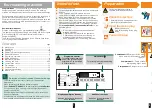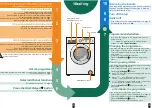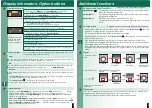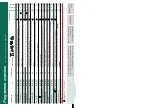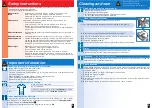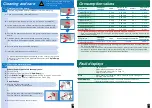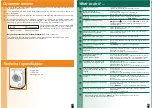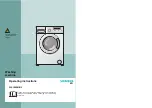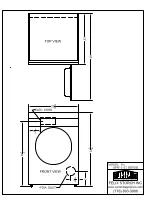
8
Safety instructions
– Read and follow the operating and installation instructions and all other information
enclosed with the washing machine.
– Retain documents for subsequent use.
Risk of electric
shock
– Never pull out the mains plug by pulling on the power cord.
– Never insert/pull out the mains plug with wet hands.
– Make sure the cable is plugged into a socket which is correctly
connected to a reliable earth connection
.
Risk of death
Appliances which have reached the end of their service life:
– Pull out the mains plug.
– Sever the power cord and discard together with the plug.
– Destroy the lock on the washing machine door.
This will prevent children from locking themselves in and putting their
lives at risk.
Risk of suffocation
– Keep packaging, plastic film and packaging parts out of the reach of
children.
Risk of poisoning
– Keep detergents and care products out of the reach of children.
Risk of explosion
– Caused by detergents containing solvents, e.g. stain remover. Items
of washing pre-treated with solvent naphtha may cause an explosion
after being loaded into the washing machine. Rinse such items
thoroughly by hand before putting them in the washing machine.
Risk of injury
– Washing machine door may become very hot.
– Take care when draining hot detergent solution.
– Do not climb on the washing machine.
– Do not lean on the washing machine door when it is open.
– Make sure that the pump cap is screwed on when the machine is
running, avoid water leakage and touching the components of pump
when they are in operation.
Important information
Preparing/Protecting the laundry and the machine
– Brush sand out of pockets and cuffs/collars.
– Check for metal items (paperclips, etc.).
– Trousers, knitwear and knitted textiles, e.g. jersey garments,T-shirts or sweatshirts should
be turned inside out.
– Wash delicates in a net/bag (tights, curtains, underwired bras).
– Close zips,fasten pillow cases/cushion covers.
– Remove curtain runners or tie up in a net/bag.
Laundry with different levels of soiling
Wash new items separately.
Light
Do not prewash.
If required, pre-treat stains. Select
+Prewash
programme.
Heavy
Load less laundry. Select
+Prewash
programme.
Before washing for the first time
Do not put any laundry in the washing machine. Turn on the tap, fill approx. 1 litre of water
and then pour ½ a measuring cup of detergent into dispenser II. Set the
Easy-Care 40
੬
programme and select
Start
/
Reload
.
At the end of the programme, set the programme selector to
Off
.
9
Cleaning and care
Clean machine housing, control panel
– Wipe with a soft, damp cloth.
– Do not use abrasive detergents.
– Immediately remove washing and cleaning agent residue.
– Do not clean the appliance with a water jet.
Clean the detergent drawer ...
... if it contains detergent or fabric softener residue.
1.
Pull out, depress the insert and remove the drawer completely.
2.
Remove insert: Press the insert upwards with your finger.
3.
Clean the detergent dispenser and the insert with water and a brush.
4.
Refit the insert and secure in place.
5.
Insert the detergent drawer.
Leave the detergent drawer open so that residual water can evaporate.
Drum
Leave the washing machine door open so that the drum can dry.
Rust stains – use chlorine–free cleaning agent, not steel wool.
Descaling
No laundry in the machine!
This should be not be necessary if the detergent is dispensed correctly. However, follow the
instructions of the descaler manufacturer.
Frost protection
If the washing machine is located in a room which is exposed to freezing temperatures, any
residual water in both the pump and the water inlet hose must be drained every time after the
machine is used.
– Draining the pump
a
Page 10 Detergent solution pump
– Draining the water inlet hose:
1.
Turn the tap off.
2.
Unscrew the hose from the tap and the rear of the appliance, drain out the water left inside
the inlet hose.
3.
Before the next wash, screw the hose back on and check for leaks.
– Risk of electric shock.
Pull out the mains plug.
– Risk of explosion. No solvents.
10
Cleaning and care
Detergent solution pump
– Set the programme selector to
Off
, pull out the mains plug.
1.
Open and remove the maintenance cover.
2.
Carefully unscrew the pump cover - do not remove it completely.
3.
Let the water drain into a shallow container (let the remainder drip
onto a floor cloth). Repeat the operation until there is no water left.
4.
Remove the pump cover. Remove foreign material/fluff from inside the
pump.
5.
Clean the interior, pump cover thread and pump housing
(fan impeller in the detergent solution pump must be able to rotate).
6.
Refit the pump cover and screw on tightly.
7.
Insert the maintenance cover and close it.
To prevent unused detergent from flowing into the outlet during the next
wash: pour 1 litre of water into dispenser
II
and start the
Å
Spin/Empty
l
programme.
Filter in the water inlet hose
Reduce the water pressure in the supply hose:
1.
Turn off the tap.
2.
Select any programme (except
Å
Spin/Empty
l
).
3.
Press
Start
/
Reload
.Leave programme running for approx. 40 seconds.
4.
Set the programme selector to
Off
. Pull out the mains plug.
Clean the filter:
1.
Remove the hose from the tap.
Clean the filter with a small brush.
or
Remove the hose from the rear of the appliance.
Remove filter with pliers and clean.
2.
Reconnect the hose and check for leaks.
1
2
1
2
– Risk of scalding. Allow detergent
solution to cool down.
– Turn off the tap.
11
Consumption values
Programme
Additional
function
Load
Electricity con-
sumption
***
Water
***
Programme
duration
***
Cottons
Êü
20
ॕ
-
4,5 kg
0,18 kWh
51 l
1:41 h
Cottons
Êü
40
ॕ
*
-
4,5 kg
0,69 kWh
51 l
1:41 h
Cottons
Êü
60
ॕ
*
-
4,5 kg
0,85 kWh
51 l
1:50 h
Cottons
Êü
90
ॕ
-
4,5 kg
1,50 kWh
58 l
2:15 h
Easy-Care
Ïü
40
ॕ
*
-
2,5 kg
0,49 kWh
48 l
1:27 h
Delicate/Silk
5ü
30
ॕ
-
2,0 kg
0,26 kWh
34 l
0:43 h
Wool
dü
É
30
ॕ
-
2,0 kg
0,13 kWh
43 l
0:40 h
*
Programme setting for testing in accordance with valid standard EN60456.
Note on comparative tests: For testing the test programmes, wash the specified load using the
maximum spin speed.
Programme
Additional
function
Load
Annual energy consumption
Annual water
consumption
Cottons
Ê
40/60
ॕ
eco Perfect
**
4,5/2,25kg
155 kWh
8900 l
**
Programme setting for testing and energy labelling in accordance with EU directive 2010/30/
EU with cold water (15 °C).
***
The values deviate from the indicated values depending on water pressure, hardness, and inlet
temperature, ambiente temperature, type, amount and soiling of the laundry, detergent used,
fluctuations in the power supply and selected additional functions.
Fault displays
E:17
– Tap turned on?
– Water inlet hose kinked or jammed?
– Filter blocked? Clean filter
a
Page 10
– Water pressure too low?
E:18
– Loose debris is blocking the pump, clean the pump
a
Page 10
– Drainage hose blocked?
Other displays
Switch off the appliance, wait 5 seconds and switch it back on.
If the display appears again, call customer service.
12
Customer service
ʑ
Before calling customer service, please check whether you can eliminate the fault yourself
a
page 13 What to do if..
.
ʑ
If you require advice, even during the warranty period, you will incur the costs for the callout
of a technician.
ʑ
The contact details for all countries can be found in the enclosed after-sales service directory.
ʑ
When calling customer service, please give details of your address, telephone number, fault
description, purchase date, product number (E-Nr.) and the production number (FD) of the
appliance to prevent unnecessary callouts. This will save you additional costs.
These numbers are shown on the rating plate
which can be found on the frame of the open
door and also on the rear of the appliance.
Rely on the professionalism of the manufacturer.
Please contact us.
This will ensure that the repair is carried out by trained service technicians who arrive
equipped with genuine spare parts for your appliance.
E-Nr.
FD
Technical specification
a= 600 mm
b= 400 mm
c= 850 mm
Net weight 60 kg
a
b
c
Product number
Production number
13
What to do if ...
ʑ
Water is running out.
– Fit/refit drainage hose.
– Tighten screw–fitting on the supply hose.
ʑ
Water not flowing in.
Detergent not washed in.
– Tap not open?
– Filter blocked? Clean filter
a
Page 10
.
– Water inlet hose kinked or jammed?
ʑ
Washing machine door cannot be
opened.
– Safety function active. Programme stopped?
– Water in drum? Select
Å
Spin/Empty
l
programme.
ʑ
Programme does not start.
–
Start
/
Reload
not selected or
Finish in
is selected?
– The
rü
symbol flashes
,
washing machine door not
closed properly.
ʑ
Detergent solution is not drained.
– Clean detergent solution pump
a
Page 10
.
– Clean drainage hose.
ʑ
Additional function could not be
activated for the selected
programme.
– Can the additional function be selected?
a
Page 7
,
programme overview.
ʑ
Water not visible in the drum.
– Not a fault - water below the visible area.
ʑ
Spin cycle actuated several times. – Not a fault - unbalanced load detection system adjusts
imbalance.
ʑ
Detergent in chamber
I
is not
washed away.
–
+ Prewash
oü
programme not selected?
ʑ
Detergent residue in the detergent
dispenser
– Detergent is damp or lumpy, clean the detergent
dispenser
a
Page 9
.
– Use the dosing aid for liquid detergent.
ʑ
Foam is emerging from the
detergent drawer.
The
t
ü
symbol flashes
– Too much detergent used?
Mix 1 tablespoon of fabric conditioner with ½ a litre of
water and pour into dispenser II in the detergent drawer.
– Reduce detergent dosage for the next wash cycle.
ʑ
Excessive noise, vibration and
“wandering” during spin cycle.
– Appliance feet fixed?
Secure appliance feet
a
Installation instructions.
– Transportation bolt removed?
Remove transportation bolt
a
Installation instructions.
ʑ
Display panel/indicator lights do
not function while the appliance is
running.
– Power failure?
– Circuit breaker tripped? Reset the circuit breaker/
change the fuse.
– If the fault occurs repeatedly, contact customer service.
ʑ
Programme sequence longer than
usual
– Not a fault-unbalanced load detection system is
adjusting the imbalance by repeatedly distributing the
laundry .
– Not a fault-foam detection system active.
ʑ
Detergent residues on the laundry – Occasionally, phosphate-free detergents contain water-
insoluble residues.
– Select
Rinse
mü
or brush the laundry after washing.
ʑ
Washing result not satisfactory
– Soiling is greater than expected? Select a suitable
programme.
– Detergent is underdosed?
ʑ
If you cannot correct a fault yourself or a repair is required:
– Set the programme selector to
Off
and pull the mains plug out of the socket.
– Turn off the tap and call customer service.
Operating instructions
Follow the safety
instructions on
Page 8.
en
WS10X261BY
Please read the operating instructions and installation
instructions supplied before switching on the washing
machine.
Washing
machine



